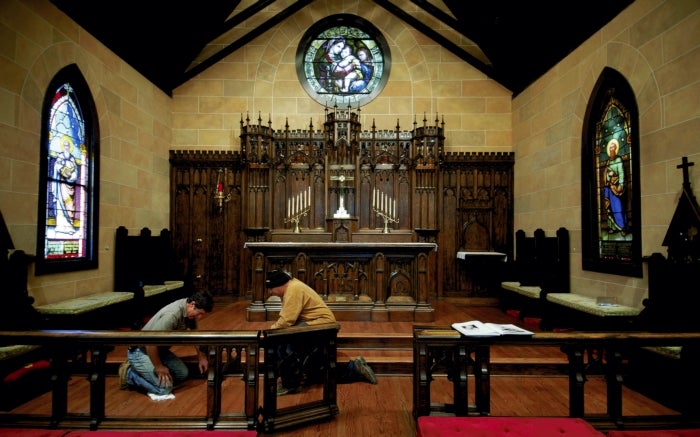Clyde, Time Was: Define the sacred and protect it
Published 5:27 pm Saturday, August 19, 2017

- Al Wilson and Tim Brown look at a plank in the altar area of St. Luke's Episcopal Church during a major renovation to the sanctuary in 2015. JON C. LAKEY / SALISBURY POST
By Clyde
Special to the Salisbury Post
Time was, there were things and places sacred. If ever you visited cathedrals or reliquaries, you immediately knew something was there, pervading, searching and saturating. Not unlike humble St. Andrews Episcopal in Woodleaf that has a homecoming once a year, the last Sunday in August. It’s thought-provoking to imagine that a small group of farmers came together in 1840 to build a “temple” of worship along the Yadkin. What prompted them to choose that spot and no other?
“The conditions of building a church on the land formerly owned by Charles Richmond Pearson on the road leading from Salisbury to Mocksville, to finish the hull of the house, 44’ x 34’ including the door and ‘winders’ and sash and running one flight ‘steers’ in the sum of $325.”
You don’t need Gothic flying buttresses and leaded stained glass to have a church. George Raynor used to say he could worship in the garden with crawdads just as well as in church. He called it St. Mary’s of the Garden. These people who want to have weddings out in the middle of a cow pasture leave something out. Barns don’t qualify as holy except for the manure.
Moses at the burning bush was outside, but don’t kid yourself; he knew God was there.
Early Christians were bad to take off their sandals or cover their eyes when they saw God. Indians had the right idea with the Great Spirit in the Sky, burial mounds and trinkets in the after life. Egyptians had more gold than God.
The Sioux Indians poked the ear drums of General Custer’s soldiers so they would listen next time. We didn’t learn. Sacred places make you quiet without being told to be.
The sacristy of any church is that room, near the altar, for vessels, flowers, the sacraments, altar hangings, and if you’re at St. Luke’s Altar Guild on Saturday mornings, you might hear words like ciborium, tabernacle, chasuble, pater, thurible and verger. The St. Lazarus chalice, given in memory of the Reverend Wheat by Mrs. Jefferson Davis from his church in Tennessee, is something to be “hold.” The bell tower, with real bells, a copy of the one in Oxford, England, the narthex out front where sinners wait, the nave; like a ship, all make for reverence. The hymnal boards with offering total and attendance from last year are no longer.
The holy altar we must have inherited from the Old Testament and heathen sacrifice. What would we sacrifice today?
Sunday was sacred too. On the sabbath day, we rested. No shopping, drinking, working. You changed your Sunday clothes after you got home from church. Sunday dinner with Sunday china and silverware, watermelon rind pickles and yeast rolls were just as sacred as the red letter edition of the Bible with all the words of Jesus in red letters. The Gideons put a Bible in every hotel room. Did that make it sacred? After dinner, you would open the big pocket doors and to “into the house” and set a spell. That’s a leftover from the days of a detached kitchen house.
Not many places do you still get to knell down these days. It puts you in your place. The holiest and most enabling sensations of the soul, the vainglorious together with the meek. Few if any children kneel down beside their bed to say bedtime prayers any more. It’s a lost time, except in pictures If they can’t test or email, how are they going to have little visits with God? Sadly, there is no need for God in their lives, and the internet has replaced Jesus. It is omnipresent and all-knowing. Just ask kids who sleep-text, clutching their cell phone. God help us.
Where are spaces you hold sacred today? Do you see God in projected images on the wall over the altar? Whey do we have activity bags for children to occupy their minds? How secular can Bible school become with super heroes? Where is Jesus in contemporary lyrics with karaoke microphones? We hold these truths to be self-evident. For too many, God’s name does not come up in everyday conversation except in profanity.
Are Confederate monuments sacred? They are to those who died and to those who memorialize them.
“Fame has given you an imperishable crown, History will record your daring valor, matchless achievements and noble suffering …”
Are Union monuments not sacred too? We have three handsome marble edifices in our National Cemetery on Military Avenue off South Main. The largest number of unknown dead were from Pennsylvania. Go see them; stop and ask yourself why they are there.
Name one sacred spot in your life. What do you do to protect them and keep them safe for our lost generation to tear down or casually to tour if not to believe in? Hopefully, the sacred world can survive the misguided, violent protests and missile attacks from North Korea. God is a very present help in trouble. Tune in, not drop out, on South Main Street in downtown America. In today’s secular world, nothing’s off limits.
Kyrie Eleison.
Clyde, who has dropped is last name, is a Salisbury artist.

